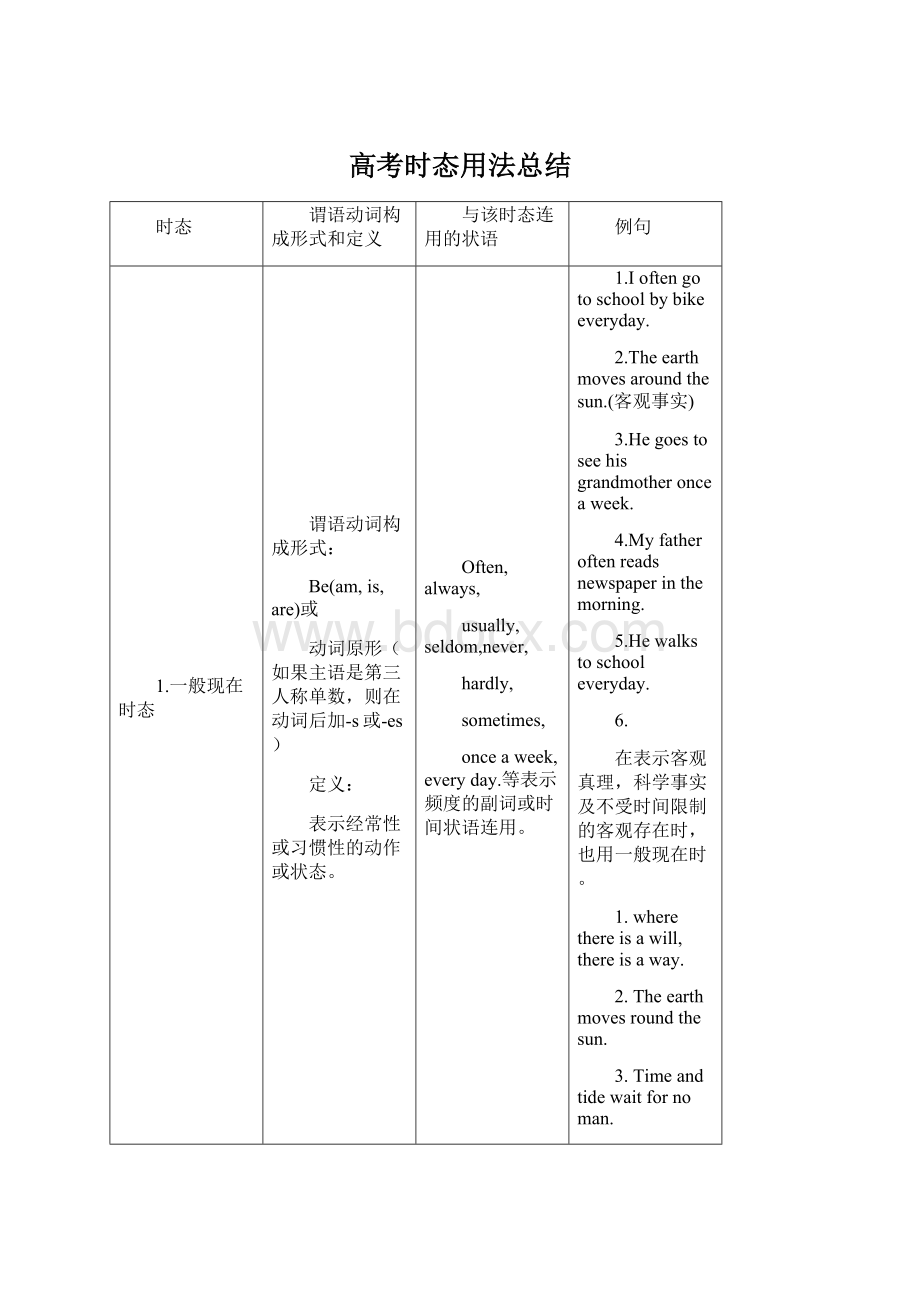高考时态用法总结.docx
《高考时态用法总结.docx》由会员分享,可在线阅读,更多相关《高考时态用法总结.docx(10页珍藏版)》请在冰豆网上搜索。

高考时态用法总结
时态
谓语动词构成形式和定义
与该时态连用的状语
例句
1.一般现在时态
谓语动词构成形式:
Be(am,is,are)或
动词原形(如果主语是第三人称单数,则在动词后加-s或-es)
定义:
表示经常性或习惯性的动作或状态。
Often,always,
usually,seldom,never,
hardly,
sometimes,
onceaweek,everyday.等表示频度的副词或时间状语连用。
1.Ioftengotoschoolbybikeeveryday.
2.Theearthmovesaroundthesun.(客观事实)
3.Hegoestoseehisgrandmotheronceaweek.
4.Myfatheroftenreadsnewspaperinthemorning.
5.Hewalkstoschooleveryday.
6.
在表示客观真理,科学事实及不受时间限制的客观存在时,也用一般现在时。
1.wherethereisawill,thereisaway.
2.Theearthmovesroundthesun.
3.Timeandtidewaitfornoman.
报刊、杂志、书籍等不强调过去时间,单纯表示客观事实时,要用一般现在时。
1.whatdoesthisarticlesay?
2.thearticledescribessocialproblems.
2.一般过去时态
谓语动词构成形式:
动词的过去式。
如:
stop—stopped
Beg—begged
Visit—visited
定义:
表示过去某时间发生的动作或存在的状态。
Lastnight,
yesterday,
lastweek,
someyearsago,in2008,inthepast.Theotherday,atthattime,justnow.
1.表示过去习惯性或经常发生的动作:
WhenIwasinthecountryside,Ioftenswamintheriver.
2.Hedidhishomeworklastnight.
3.Theywerestudentsatthattime.
3.现在进行时态
谓语动词构成形式:
Be(am,is,are)+ving.
定义:
表示此时此刻正在进行的动作。
Now,
thesedays.
Atthemoment.
1.Iamreadingnovelsnow.
2.TheyarestudyingEnglishthesedays/thisterm.
4.过去进行时态
谓语动词构成形式:
Was/were+ving.
定义:
表示过去某一时刻或过去一段时间内正在进行的动作。
Then,atthattime,thistimelastyear,atnineyesterday.等连用,或用另一动作表示过去的时间。
1.--Whatwereyoudoingattenyesterday?
--IwaswatchingTVatthattime.
2.HewasreadingwhenIcamein.
3.IwasdoingmyhomeworkwhilemyparentswerewatchingTV.
4.Hewasplayingfootballthen/atthattime.
5.一般将来时态
谓语动词构成形式:
Will+动词原形
begoingto+动词原形
定义:
常表示计划、打算作某事,表示已经决定的、很可能发生的事,或有某种迹象表明要发生的事情。
表示将来发生的动作或存在的状态。
Tomorrow,nextweek,inafewdays,nextSunday,in+一段时间,in2015.等。
1.---WhatareyougoingtodonextSunday?
----I’mgoingtolistentomusic.
2.lookattheclouds,thereisgoingtobeastorm.
3.Thesunwillriseat6:
30tomorrowmorning.
4.wewillhelphim,ifheasksus.
6.过去将来时态
谓语动词构成形式:
Would+V
定义:
表示从过去某一时间看将来发生的动作或存在的状态。
常用在谓语动词为过去式的宾语从句中。
2.表示过去的习惯性动作
1.Heaskedwhenthemeetingwouldend.
2.Hesaidhewouldbuysomefruitforhermother.
3.I thought you would take the chance.
4.He said he would come back the next day.
表示过去的习惯性动作
1.Whenever she had time, she would help us in our work.
2.Every evening she would come and talk with the students
7.现在完成时态
谓语动词构成形式:
Have/has+动词的过去分词
定义:
表示过去发生的或已完成的某一动作对现在造成的影响或结果。
一些非延续性动词和表示一段时间的状语连用时的变化。
Go/leave-beaway
Come-behere
Buy—have
Borrow-keep
Finish—beover
Die–bedead
Begin/start—beon
Catchacold—haveacold
Puton—wear
Getup–beup
Wakeup---beawake
Fallasleep—beasleep
Lose–nothave
Join---be(in)
Leave—beawayfrom
Arrive/reach--be
Already,用于肯定句,可放在助动词之后,过去分词之前。
也可放在句末。
Yet用在疑问句中意为“已经”;用在否定句中表示“还,尚”,常用于句末。
Just“刚刚”表示动作刚刚结束,常放在助动词与过去分词之间。
Ever“曾经”用在疑问句或否定句中,放在助动词与过去分词之间。
Never“从来没有”常与before连用。
多放在助动词和过去分词之间。
Before“以前”指过去不确定的时间,总放在句末。
“since+过去时间点”“for+时间段”
1----.Haveyouhadyourlunchyet?
----yes,Ihave.I’vejusthadit.
2.Ihavelostmybag.
3.IhavealreadywatchedtheTVplay.
4.---Haveyoufoundyourlostpenyet?
---No,Ihaven’tfoundityet.
5.HehasjustcomebackfromNewYork.
6.HaveyoureverbeentoTianjin?
7.Ihavenevertraveledbytrainbefore.
8.IhavelivedinTianjinfor10years.
9.IhavelivedinTianjinsince2000.
10.IhavelivedinBeijingsinceIwasgraduatedfromschool.
8.过去完成时态
谓语动词构成形式:
Had+动词的过去分词
定义
表示到过去某个时间已经完成的动作或状态。
即“过去的过去”
2.过去完成时常用于“nosooner---than”和“hardly(scarcely—when(before)”等结构中,从句常用一般过去时,“nosooner,hardly(scarcely)”置于句首时,要用倒装语序。
Bylastyear,bylastweek,byyesterday,bylastmonth.
Bytheendoflastyear.等。
1.Hehadfinished2/3oftheworkbylaskweek.
2.HehadleftbythetimeIarrived.
3.HehadlivedinBeijingfor5yearsbeforehecametohere.
4.Smithdiedyesterday,hehadbeenafriendofmine.
5.Thechildrealizedthathehadlosthisway.
6.IknewIhadmadeamistakeatthattime.
1.Nosoonerhadhereachedhomethanitbegantorain.
2.Hehadhardlygotonthetrainwhenthetrainstartedout.
9.现在完成进行时态
谓语动词构成形式:
Have/hasbeen+ving
定义:
表示一个动作从过去某开始,一直持续到说话时还在继续或刚刚结束。
常与表示一段时间的状语连用。
For3years,thesefewweeks,sinceearlymorning.
1.IhavebeenteachingEnglishfortwentyyears.
2.ShehasbeenplayingthemusicofBeethovenandMozartfortwohours.
3.I’vejustbeenwavinggoodbyetoher.
10.将来进行时态
谓语动词构成形式:
will+be+ving
定义:
表示在将来某一时间正在进行的动作,常表示安排好之事,给人一种期待感。
Thistimetomorrowmorning,
At7:
00tomorrow,
Atthattimenextweek.等连用。
1.Iwillbewatchingthesunriseatthetopofthemountainthistimetomorrow.
2.Iwillbehavingameetingtonight.
表示预料不久要发生或势必发生的动作。
1.Isupposetheywillbeleavingsoon.
2.Maybefewerpeoplewillbesmokinginfiftyyears.
11.将来完成时态
谓语动词构成形式:
Will/shall+have+
Done
定义:
表示将来某时刻之前或某一行为发生之前所完成的动作。
常和bythetime,
bytheendofnextyear,或beforenextsummer,等结构连用。
1.I’llhavearrivedtherebynoon.
2.I’llhavefinishedreadingthebookbytheendofthisweek.
3.whenwegettherethey’llprobablyhaveleft.
表示到将来某时刻为止动作的持续时,也可以用将来完成时。
1.I’llhavelivedinthecityfortwentyyearsbynextmonth.
2.I’llhavedonetheworkforthreemonthsbyFriday.
现在完成时与现在完成进行时态的区别
在与表示一段时间的状语连用时,现在完成时和现在完成进行时均可表示一个动作从过去某时开始延续到说话时,并可能延续下去,在一定的上下文中,这两个时态可以互换。
1.Ihavetalkedtothestudentsfortwohours.
我已经同该生谈了两个小时。
(强调可能完成)
Ihavebeentalkingtothestudentsfor2hours.我一直同该生交谈,已经谈了两个小时了。
(强调可能还在继续)
现在完成进行一般不使用于状态动词,要表示状态动词的“未完成用法”只能用现在完成时态。
(注:
状态动词表示感受、情感、看法、认识、愿望、及所有关系等状态含义,如be,belong,exist,feel,hatelove,want等。
They________eachothersincechildhood.
A.havebeenknowingB.knew
C.haveknownD.hadknow
在不用时间状语时,现在完成时态表示动作已结束,而现在完成进行则表示动作仍在进行。
1.Hehaswrittenanessay.他已经写好了一篇论文。
(表明动作已经完成)
2.Hehasbeenwritinganessay.他一直在写论文。
(表示动作仍在继续)
用howlong--?
结构询问目前正在进行的动作的时间长度时,多用现在完成进行时。
HowlonghaveyoubeenlivinginTianJin?
Howlonghaveyoubeenlisteningtomusic?
像sit,lie,wait,stay,stand等动词更趋向于用现在完成进行时。
Theoldmanhasbeensittinghereallthemorning.这老人一上午都坐在那儿
Thestudentshavebeenwaitingfortheirteacher.学生们一直在等他们的老师。
一般过去时与现在完成时态的区别
一.一般过去时只表示过去的动作而不强调对现在的影响,而现在完成时则强调过去的动作对现在造成的影响。
1.Ihavereadthebook我已经读过这本书。
2.Ireadthebooklastyear.我去年读过这本书。
3.Didyougetupearly?
你起床早吗?
4.Havetheygotup?
他们已经起来了吗?
二.现在完成时的动作开始于过去,现在仍在继续;而一般过去时的动作早结束。
Hehasworkedinthiscompanyforthreeyears.
他在这家公司已经工作三年了。
(现在仍在此公司工作)
Heworkedinthiscompanyforthreeyears.
他在这家公司工作过三年。
(现在已不再这家公司工作了)
三.现在完成时态表示的动作发生在过去的一个不确定的时间,常与already,yet,never,just,before等连用;一般过去时表示过去某个确定的时间发生的动作,常与表示过去的具体时间连用。
Ihavealreadyfinishedthebook.我已经看完了那本书。
Weoncelivedinthecountryside.我们曾在农村住过。
Ihaven’tseenherbefore.我以前从没见过她。
Ihaven’tseenheronce.我一次也没见过她。
Isawhimlastweek.我上星期见过她。
过去完成时与一般过去时的区别
一.一般过去时表示相对于现在而言的过去时间,而过去完成时表示的则是相对于过去某一时刻而言的过去的时间,即过去的过去。
它的存在以过去的某一动作或某一时刻为参照物而言的。
1.Allthestudentshadbeentherebefore5o’clockyesterdayafternoon.
2.Allthestudentsgotthereat5o’clockyesterday.
主将从现得用法
在时间when,before,after,assoonas,或条件if,unless状语从句中,主句用将来时,时间或条件状语从句要用一般现在时态代替将来。
1.Unlessyougetridofsmoking,youwillnotstayhealthy.
2.Whenyoucomenexttime,I’llshowyouaroundourcampus.
3.IfIseehim,Ishalltellhimthenews.
4.ifitrainstomorrow,wewon’tgotothepark.
5.whenIgrowup,Iwillbeascientist.
6.Ifitdoesn’trainthisafternoon,we’llhaveafootballmatch.
7.ifitrainstomorrow,wewillstayathome.
8.We’llgivehimthemessageafterhefinishesdinner.
9.I’llcallyouassoonasIgettoBeijing.
在让步whenever,nomatterwhat状语从句中,常用一般现在时表将来。
Wheneverherdrivesortakesthetrain,he’llbehereontime.
Nomatterwhathappens,don’tbediscouraged.
一般现在时表将来
表示已经做出的决定、安排好的事情,将来预定要发生的事情。
这种用法多用来谈论时间表、节目单,日程表等安排好的事情。
一般现在时可与某些含“出发,到达”之意的动词连用,即用于表示转移的动词(如:
come,go,arrive,leave,start等),表示预定的行为,即将来的但已事先安排好的动作,这种安排很固定,不容易改变。
1.theplanetakesoffatthreeo’clockP.M.飞机下午三点起飞。
2.Thefilmshowbeginsinaminutes.电影一会就开始。
3.ThereisalectureonEnglishwritingtonight.
4.Thetrainsleavesatnineo’clock.
Thetrainsarrivesat8:
30andleavesat8:
45.
现在进行时态表将来的用法
Come.Go,leave,arrive,start等动词用进行时表将来。
IamgoingtoBeijingthisSunday.
WeareleavingforNewYorkaftertheperformance.
Sheisgivingapianorecitalnextweek.